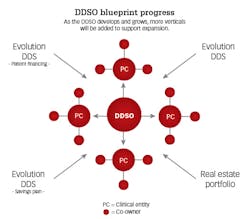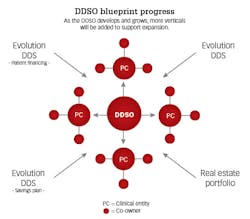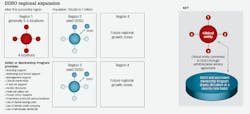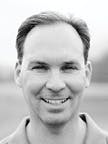DDSO blueprint series, Part 1: Action steps for dentist-owned private group models
By John Pasiczynk, DDS
Introduction by Brady Frank, DDS
Editor’s note:This article is part one of a five-part series. Part two will appear in July.
Thank you for the tremendous response and hundreds of emails generated by the three-part dentist-owned dental support organization (DDSO) series that ran in Dental Economics October through December 2017. An overwhelming number of readers have asked for additional articles related to actionable steps needed for establishing one of the DDSO models in their own private practices, dental support organizations (DSO), or groups.
This five-part series is dedicated to highlighting the top 1% of practices around the country that have successfully converted to a personalized DDSO model and are reaping the benefits. Using real-life examples, actionable steps will be given to help you build your own DDSO blueprint with the affiliated streams of income, tax savings, and funnels. To kick off this series is John Pasiczynk, DDS, owner of four locations in the great state of Indiana. He is a wonderful example of reaping benefits through conversion to a DDSO model.
Discussion by John Pasiczynk, DDS
One of the most rewarding parts of dentistry is owning a small business. In fact, when I present on the topic of practice ownership, the majority of established dentists state that practice ownership is one of the reasons they chose dentistry in the first place. Practice ownership used to be a given when you started off in dentistry. It wasn’t a question of “if” but “when.” There was a time where a new dentist simply hung a shingle outside the door with the word “Dentist” engraved on it and watched new patients come in the door. Dentists starting in the profession today are facing a number of new challenges that make the traditional route of practice ownership increasingly difficult to realize.
The cost of education is sending some new dentists into the world with hundreds of thousands of dollars in student loan debt. For them to consider additional debt in the form of a practice loan is more than they can handle, so they are left to find great associateships while they pay down loans. However, there is a large number of dentists entering the workforce, making it difficult for new dentists to find a great job. Large corporate group practices, including DSOs, are acquiring private practices across the country, drastically changing the types of practices available in which to work. For those fortunate enough to purchase a practice or find a job, insurance reimbursements continue to decrease while the consumer mindset of patients is demanding faster, cheaper, and better solutions. Sounds like a risky decision to purchase your own practice, now doesn’t it?
As a profession, we are facing a decision. Do we refuse to adapt to the challenges facing us, or do we change the way we think as a group and adopt a new practice model? If we choose the former, the private practice model will slowly but assuredly die off, leaving a smaller number of solo private practices. But if we choose to change our mindset for what it means to own a practice, we can keep the private practice around indefinitely, allowing more dentists to realize all of the amazing benefits of business ownership and keep the practice of dentistry in the hands of dentists.
In order to combat the challenges facing us, I made a decision to change the rules of the game and start my own dentist-owned DSO, or DDSO. The DDSO is similar to the DSO in some ways but very different in others. The DDSO has developed frameworks, which are really a compilation of best practices, that are instituted by the practice with the owner-dentist’s blessing. The frameworks provide systems for business operation, marketing, new patient protocol, training, etc. Because each practice is individually owned by partners, they each have the ability to adjust any of the frameworks to fit their particular practice with the DDSO’s assistance. This means the DDSO and practice have an affiliate-type relationship with the DDSO maintaining no real “control” over the practice.
The DDSO also provides a few core services that save money and increase efficiency within the practice. By negotiating on behalf of all of the affiliates and using a select group of vendors, the DDSO obtains much better pricing from vendors for dental supplies, labs, marketing services, maintenance, service contracts, and other third-party services that are necessary to operate a business. This increases cash flow to the affiliate practices and puts more cash in the partner doctor’s pocket for no additional work. HR services are integrated into one centralized location, saving the partner doctor’s time and effort in maintaining the necessary compliance by keeping appropriate records of employment, discipline, and training, which are a must in today’s increasingly litigious environment. Finally, the DDSO provides mentoring, training, and leadership support for the partner doctors as they develop in their careers. With partner doctors ranging in years of experience and clinical expertise, the DDSO is a great setup for group learning and individual mentoring and support.
By maintaining the value of the practice within the practice, rather than the DDSO, any practice growth is equity that the practice owner is earning, rather than the DDSO entity. Because of all the advantages the DDSO brings to the table, it is common to see significant practice growth and an increase in value. Depending on the exact DDSO structure, the existing partners share in the capital that is raised by selling a new partnership in the practice. The DDSO does not exist to pull all the profit out of the practices and into the “management company.” Each practice that is aligned with the DDSO is a separate legal entity that holds ownership of all assets and goodwill, employs its entire workforce, and ultimately makes its own decisions.
As a founding member of the DDSO Alliance, I am able to leverage my resources with those of other DDSOs across the nation: shared recruiting resources, sophisticated software to build my own dental savings and in-house financing plans, wholesale lab relationships, a variety of marketing funnels, and mentorship resources are some components that I have added successfully to my DDSO structure. As I have added these resources to my group I have achieved tax savings due to recent tax law changes that specifically benefit nonclinical flow-through entities like the DDSO and through ownership buy-ins that are taxed at the lowest tax level, the long-term capital gains rate. I now have an organized structure in place to scale my growth. I am able to grow without debt through allowing ownership to other like-minded dentists who reap equity as the group grows. Though I love clinical dentistry, it has become clear that the DDSO model allows for the clinical practice of dentistry out of desire as opposed to financial necessity.
Figures 1 and 2 show diagrams of my current practice and DDSO structure, while Figure 3 shows a blueprint for the expansion of our DDSO throughout the state of Indiana.
Figure 1: A simplified schematic of the growth plans related to scaling a DDSO like Evolution DDS. This also relates to the DDSO Mentorship Program to be detailed in a future article in this series.
Figure 2: As a DDSO, Evolution DDS has incorporated multiple vertical organizations and streams of income to add value to the associated clinical locations. As the group grows, individual dentists benefit from the economy of scale of the vertical value components (supply and lab discounts, software, branded savings plan and in-house financing, marketing and automation funnels, etc.).
I am now in the process of opening in several new regions of the state as I allow others to experience the same level of success and influence that I have through multilocation ownership. Building out the components of my DDSO has allowed me to do so without sacrificing family time, recreation, or my love of national and international lecturing on CBCT technology, CEREC, group practice, and other engaging topics.
Figure 3: Blueprint for DDSO expansion
Comments by Brady Frank, DDS
Dr. Pasiczynk has certainly risen to the occasion and secured his future, as well as created a clear path and blueprint to reproducible success for colleagues in his group. Action step one is to have a qualified DDSO attorney create your DDSO entity (generally an LLC) with an appropriate operating agreement. Step two is to connect your clinical practice entity to the DDSO through an administrative services agreement. Once this is complete, you will qualify for a tax deduction of up to 20% of the net qualified business income based on the new Internal Revenue Code section 199A. I have worked with dozens of dental, transition, DSO, and DDSO advisors over the past 19 years and am happy to make a referral.
Stay tuned for part two of this series next month, wherein the growth and uniqueness of a DDSO model of a two-location group in Michigan will be examined as a case study. Learn how to start your own private equity company, brand your own dental savings plan software and services, and build your own wholesale lab as you continue building the framework and architecture to your DDSO blueprint.
Author’s note: To receive the most value from this series, please email [email protected] to receive a PDF of the 2017 three-part DDSO series.
Brady Frank, DDS, is an international clinical and business lecturer, inventor, and founder of multiple companies in the dental space. He has owned multiple private dentist-owned groups (DDSOs) since 2001 when he graduated from the Marquette University School of Dentistry. He is a founding member of the DDSO Alliance and may be reached at [email protected]. Text “freebook” to 31996 for further information on his DDSO book.
John Pasiczynk, DDS, is the founder of a four-location private dental group (DDSO) in Indiana. He is active on the international clinical lecture circuit as he serves as a key opinion leader in relation to CBCT technologies, CEREC, and growth strategies related to multidoctor, multilocation practice ownership. He is a founding member of the DDSO Alliance and may be reached at [email protected].
About the Author
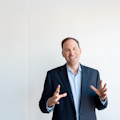
Brady Frank, DDS
Brady Frank, DDS, is a third-generation dentist turned entrepreneur, inventor, author, and thought-leader with a passion for teaching others the hard-won lessons he has learned about successfully creating and selling a business. Dr. Frank has expertise on multi-doctor and multi-location private group practices, dental transitions, DSO and DDSO expansion and growth strategies, and healthcare real estate investment, and is most passionate about mentoring others on these topics.
